I’m sorry I haven’t written anything in a while. I’ve had some university deadlines and I’ve been busy organising Batsoc stuff. I literally had no time to write this in one go, especially with all the photos I took and needed some explanation as well…
A couple of Saturdays ago, the re-enactment group went on a pretty epic trip to Leeds Armoury in Yorkshire, England. Since it’s an armoury, this will mainly be a weapons post (sorry to the crafters). There are also a lot of photos, and I want to apologise for the appalling quality of the photos – my camera is just plain rubbish, and I can’t afford a new one.
First, the ancient stuff (my academic specialty). There was only one room for this, largely because England is a rather long way away from Italy, Greece, Libya, Iraq and Iran – so items were mainly from Roman Britain and Viking Britain.
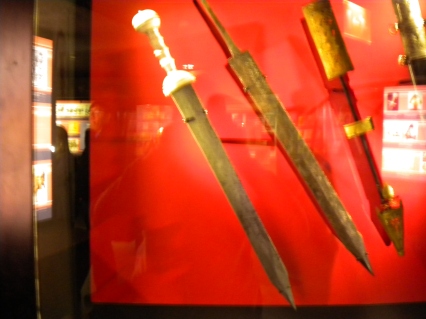
Above shows their small (but well-preserved) collection of gladii – the short-sword of choice for the Roman infantry mainly built for stabbing the enemy when they have crunched into their front-line at close quarters. They typically had a ton of metal going into the grip (seen on the right) and the grip was then built up over the top, and could be made out of anything from wood to ivory, and could be incredibly ornate.
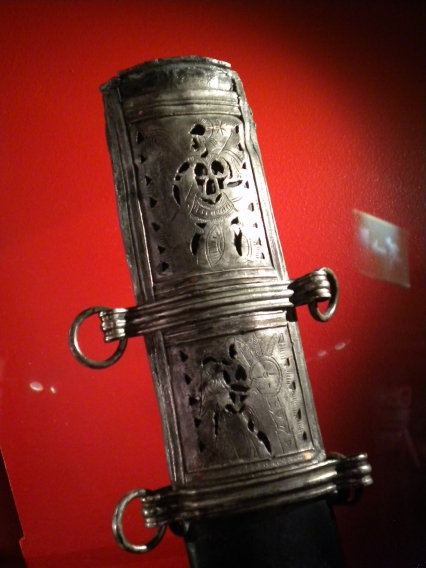
As could the vagina (yes, I had to include the hilarious Latin name for the sheath). These were made of wood covered in leather, and then had metal plates to decorate it in openwork. The example here has a plate of a warrior, and is actually relatively simple in comparison with what the Romans were capable of.
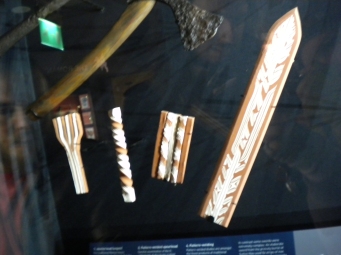
Next was something I found very interesting. The Vikings and Anglo-Saxons developed a way of strengthening the steel in their blades. They would twist pieces of iron together and then hammer them into the shape of the blade. In real terms, this gave their blades a “shimmer” or a “ripple”, and helped strengthen them. 
We spent a lot of time in the 15th and 16th century tournament section, and listened to a talk about the tournament between Henry VIII and the king of France. There were some mental items – one of which was the helmet given to Henry VIII by Maximillian, Holy Roman Emperor. Clearly not all of these were practical, as they would be for show, but for certain parts of the tournaments (like the melee combats) they could be very practical.
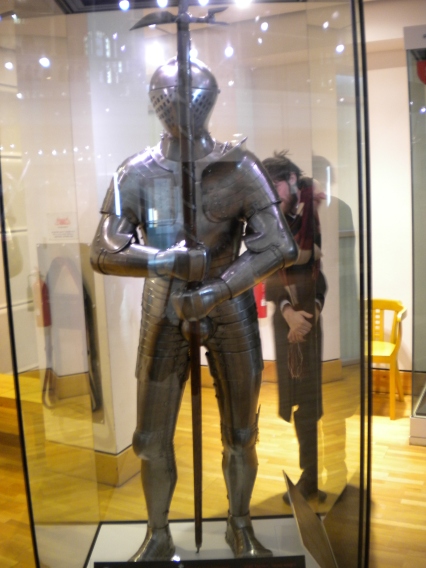 One of these ridiculously practical pieces was the tournament armour for Henry VIII. All of the sections of the armour fit so well together that NASA themselves looked at it when they were developing space suits to try and keep the astronauts inside them as sealed away from space as possible. Then the French changed the rules, saying that he needed to wear a skirted suit in order to compete. Personally, I like the pollaxe he’s holding *manic grin*.
One of these ridiculously practical pieces was the tournament armour for Henry VIII. All of the sections of the armour fit so well together that NASA themselves looked at it when they were developing space suits to try and keep the astronauts inside them as sealed away from space as possible. Then the French changed the rules, saying that he needed to wear a skirted suit in order to compete. Personally, I like the pollaxe he’s holding *manic grin*.
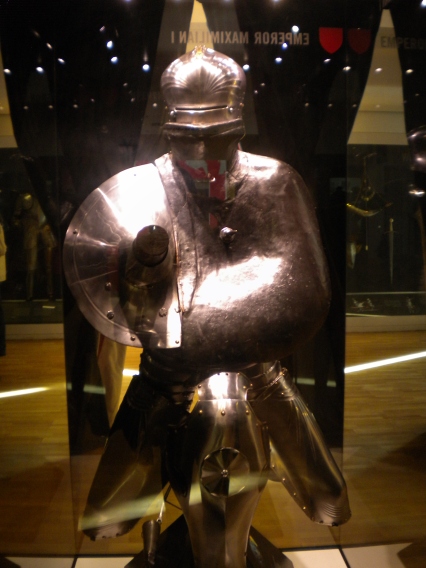 The extreme end of the practical suits came with Emperor Maximillian’s armour for titled jousting – because in jousts you aim for the face, there’s only a slit so knows where to aim. His entire left side was covered in one piece of (what I think was) wood and leather. What I found interesting was that certain parts of this armour was designed to explode to allow the wearer out of the armour easier.
The extreme end of the practical suits came with Emperor Maximillian’s armour for titled jousting – because in jousts you aim for the face, there’s only a slit so knows where to aim. His entire left side was covered in one piece of (what I think was) wood and leather. What I found interesting was that certain parts of this armour was designed to explode to allow the wearer out of the armour easier.
I then found all the sections to do with Eastern weapons in all shapes and forms. Basically – ALL OF THE PRETTIES!!!
*ahem*
To put it bluntly: they had some mental weapons and armour.
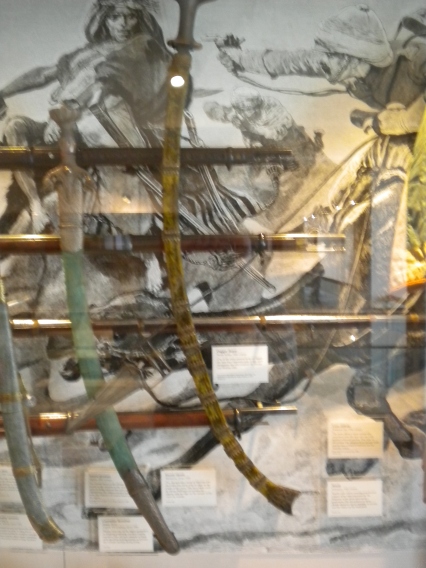 The Abyssinian sword in the yellow scabbard (sorry for the poor quality picture) was for hacking. Only one side of the blade was sharp, but contrasting with what we would normally think, the blade was on the inside of the curve. Like I said: mental weapons.
The Abyssinian sword in the yellow scabbard (sorry for the poor quality picture) was for hacking. Only one side of the blade was sharp, but contrasting with what we would normally think, the blade was on the inside of the curve. Like I said: mental weapons.
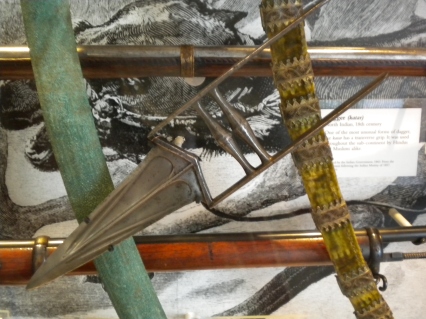 This wasn’t limited just to swords. Daggers were just as crazy. They didn’t have a “normal” handle, but one that ran transverse to the blade. I like to think that you end up stabbing people like Wolverine, but in waaaaaaay prettier clothes.
This wasn’t limited just to swords. Daggers were just as crazy. They didn’t have a “normal” handle, but one that ran transverse to the blade. I like to think that you end up stabbing people like Wolverine, but in waaaaaaay prettier clothes.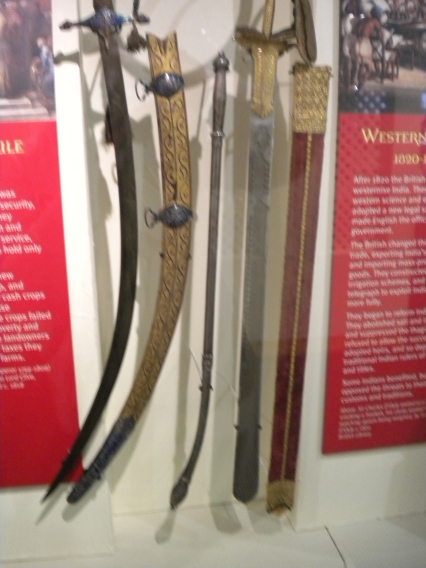 Again, sorry for the poor quality, but I had to show this mace. It’s the thin one in the middle. Take another look – I promise I’m telling the truth. And it’s made of metal. Considering how maces were made not to slash, but to obliterate your insides – a metal mace like that will definitely do some damage!
Again, sorry for the poor quality, but I had to show this mace. It’s the thin one in the middle. Take another look – I promise I’m telling the truth. And it’s made of metal. Considering how maces were made not to slash, but to obliterate your insides – a metal mace like that will definitely do some damage!
 Now for some epic things I found. This is basically a machete from Indonesia (I think – apologies if this is wrong), but have you SEEN the blade on that thing?!? Needless to say, I don’t want to be on the receiving end of that…
Now for some epic things I found. This is basically a machete from Indonesia (I think – apologies if this is wrong), but have you SEEN the blade on that thing?!? Needless to say, I don’t want to be on the receiving end of that…
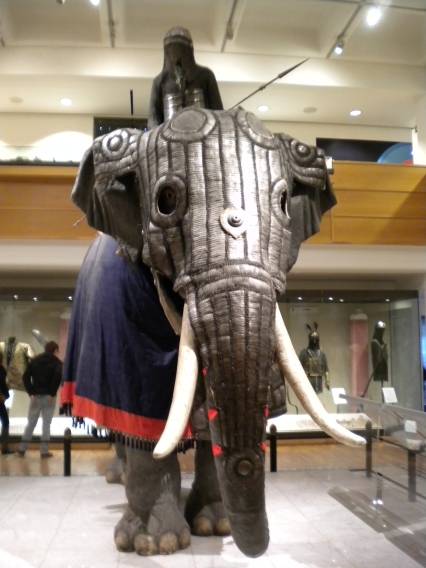 Last thing from the Eastern section: elephant armour!! What I find most weird about this is what the rider was wearing. I’ll let you take another look. The guy has loose maille over his face. With no holes for his face or his eyes. A couple of the other pieces of maille like this did have eye-holes, but they looked even weirder. It makes sense – no need for a heavy helmet to cover your entire face that you can’t breathe through, but still. Chainmail on face. That’s not a fun thought.
Last thing from the Eastern section: elephant armour!! What I find most weird about this is what the rider was wearing. I’ll let you take another look. The guy has loose maille over his face. With no holes for his face or his eyes. A couple of the other pieces of maille like this did have eye-holes, but they looked even weirder. It makes sense – no need for a heavy helmet to cover your entire face that you can’t breathe through, but still. Chainmail on face. That’s not a fun thought.
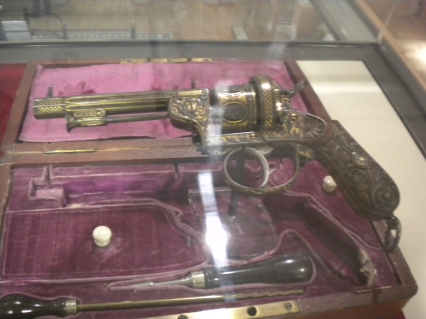 Next is the shiniest thing I have ever seen. It’s genuinely from the nineteenth century – but wouldn’t look out of place with my steampunk outfit…
Next is the shiniest thing I have ever seen. It’s genuinely from the nineteenth century – but wouldn’t look out of place with my steampunk outfit…
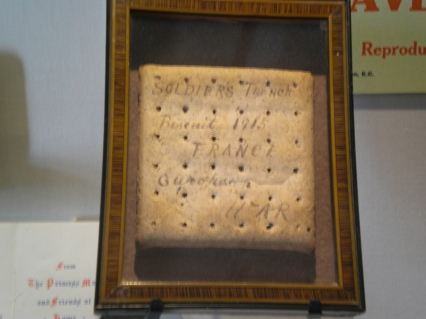 I thought this was a brilliant way of remembering that people in wars (mainly World War 1) were just that – people. It’s actually a biscuit preserved from World War 1.
I thought this was a brilliant way of remembering that people in wars (mainly World War 1) were just that – people. It’s actually a biscuit preserved from World War 1.
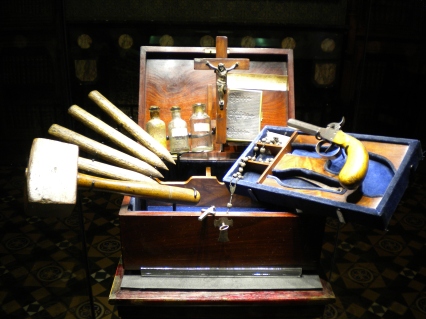
Finally, one of my favourite items from the collection. The Vampire Hunter’s kit. There was a huge surge in people buying boxes like this after Bram Stoker’s Dracula. It was one of those things that reminds you that fans are not a new phenomenon, and even the Victorians had their own version of Forbidden Planet.
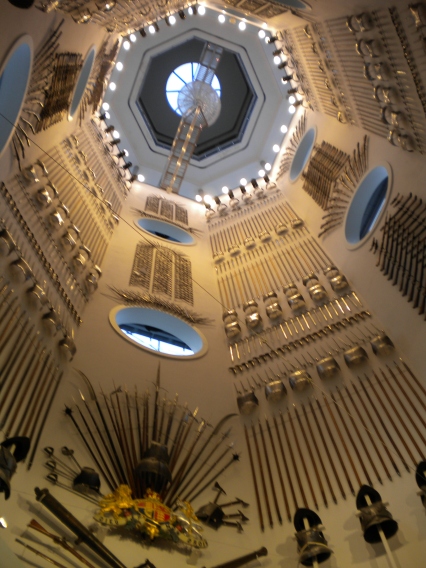
I’ll leave you with the image at the bottom of the Hall of Steel. This was where they displayed armour from all time periods in the most epic way possible.




 One of these ridiculously practical pieces was the tournament armour for Henry VIII. All of the sections of the armour fit so well together that NASA themselves looked at it when they were developing space suits to try and keep the astronauts inside them as sealed away from space as possible. Then the French changed the rules, saying that he needed to wear a skirted suit in order to compete. Personally, I like the pollaxe he’s holding *manic grin*.
One of these ridiculously practical pieces was the tournament armour for Henry VIII. All of the sections of the armour fit so well together that NASA themselves looked at it when they were developing space suits to try and keep the astronauts inside them as sealed away from space as possible. Then the French changed the rules, saying that he needed to wear a skirted suit in order to compete. Personally, I like the pollaxe he’s holding *manic grin*. The extreme end of the practical suits came with Emperor Maximillian’s armour for titled jousting – because in jousts you aim for the face, there’s only a slit so knows where to aim. His entire left side was covered in one piece of (what I think was) wood and leather. What I found interesting was that certain parts of this armour was designed to explode to allow the wearer out of the armour easier.
The extreme end of the practical suits came with Emperor Maximillian’s armour for titled jousting – because in jousts you aim for the face, there’s only a slit so knows where to aim. His entire left side was covered in one piece of (what I think was) wood and leather. What I found interesting was that certain parts of this armour was designed to explode to allow the wearer out of the armour easier. The Abyssinian sword in the yellow scabbard (sorry for the poor quality picture) was for hacking. Only one side of the blade was sharp, but contrasting with what we would normally think, the blade was on the inside of the curve. Like I said: mental weapons.
The Abyssinian sword in the yellow scabbard (sorry for the poor quality picture) was for hacking. Only one side of the blade was sharp, but contrasting with what we would normally think, the blade was on the inside of the curve. Like I said: mental weapons. This wasn’t limited just to swords. Daggers were just as crazy. They didn’t have a “normal” handle, but one that ran transverse to the blade. I like to think that you end up stabbing people like Wolverine, but in waaaaaaay prettier clothes.
This wasn’t limited just to swords. Daggers were just as crazy. They didn’t have a “normal” handle, but one that ran transverse to the blade. I like to think that you end up stabbing people like Wolverine, but in waaaaaaay prettier clothes. Again, sorry for the poor quality, but I had to show this mace. It’s the thin one in the middle. Take another look – I promise I’m telling the truth. And it’s made of metal. Considering how maces were made not to slash, but to obliterate your insides – a metal mace like that will definitely do some damage!
Again, sorry for the poor quality, but I had to show this mace. It’s the thin one in the middle. Take another look – I promise I’m telling the truth. And it’s made of metal. Considering how maces were made not to slash, but to obliterate your insides – a metal mace like that will definitely do some damage! Now for some epic things I found. This is basically a machete from Indonesia (I think – apologies if this is wrong), but have you SEEN the blade on that thing?!? Needless to say, I don’t want to be on the receiving end of that…
Now for some epic things I found. This is basically a machete from Indonesia (I think – apologies if this is wrong), but have you SEEN the blade on that thing?!? Needless to say, I don’t want to be on the receiving end of that… Last thing from the Eastern section: elephant armour!! What I find most weird about this is what the rider was wearing. I’ll let you take another look. The guy has loose maille over his face. With no holes for his face or his eyes. A couple of the other pieces of maille like this did have eye-holes, but they looked even weirder. It makes sense – no need for a heavy helmet to cover your entire face that you can’t breathe through, but still. Chainmail on face. That’s not a fun thought.
Last thing from the Eastern section: elephant armour!! What I find most weird about this is what the rider was wearing. I’ll let you take another look. The guy has loose maille over his face. With no holes for his face or his eyes. A couple of the other pieces of maille like this did have eye-holes, but they looked even weirder. It makes sense – no need for a heavy helmet to cover your entire face that you can’t breathe through, but still. Chainmail on face. That’s not a fun thought. Next is the shiniest thing I have ever seen. It’s genuinely from the nineteenth century – but wouldn’t look out of place with my steampunk outfit…
Next is the shiniest thing I have ever seen. It’s genuinely from the nineteenth century – but wouldn’t look out of place with my steampunk outfit… I thought this was a brilliant way of remembering that people in wars (mainly World War 1) were just that – people. It’s actually a biscuit preserved from World War 1.
I thought this was a brilliant way of remembering that people in wars (mainly World War 1) were just that – people. It’s actually a biscuit preserved from World War 1.
